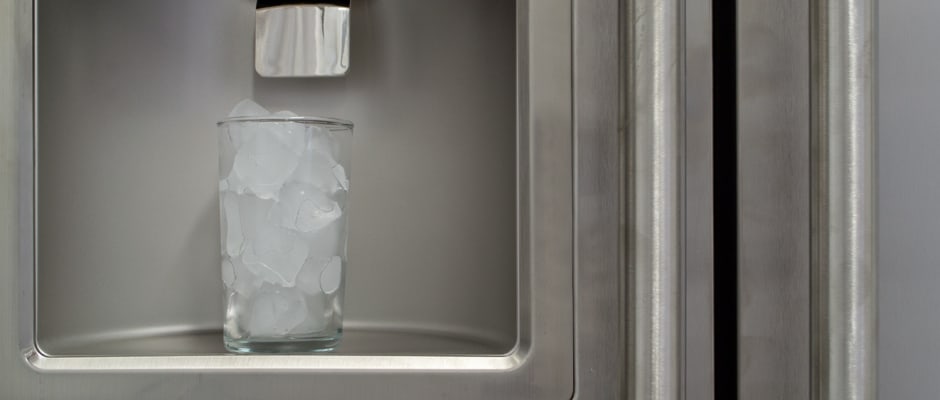Design & Usability
Side-by-side woes.
The {{product.name}}'s design is hampered by one main flaw: it's a side-by-side. That affects everything. Since the individual cavities in side-by-sides are half the width of those in your typical fridge, it can be tricky to reach items in the back, and big deli platters, pizzas, and cakes just won't fit. This Electrolux swaps most shelves for drawers, which may not gel with your food storage habits. If you're as tall as I am, the fridge's height makes it possible to use the fridge without leaning down. Of course, this advantage bites back when you bend down to grab something out of the freezer. You can't win 'em all.
The fridge door has movable shelves, but lacks a covered butter area. Toward the bottom, there are four rows of can storage, and you can fit three sodas or beers on each. Drink storage is a nice use of that harder-to-reach space because you don't have to scrutinize any labels or search for the proper can, as you might while searching for the grainy Dijon. Down by the can storage, one of the two crisper drawers has two cavities with separate moisture controls, for proper storage of fruits and vegetables.
On the outside, the control panel and ice dispenser are easy to use. There's a button for everything, instead of complex menus, which makes the panel look a bit busy. Luckily, the panel only illuminates when you press a button, so it's not too garish.
Behind the left door, the icemaker hogs a ton of space toward the top. The freezer only has two shelves, neither of which seems that large. Most of the freezer is divided into drawers which don't reach all the way back. That waste of space is especially frustrating, since this is already a shallow counter-depth. Having so many small drawers might be useful for access, but it makes the fridge feel more cramped than it would otherwise.
{{ gallery "design", "attachment2" }}
Performance & Features
The freezer just isn't that cool.
The fridge ran smoothly at a couple degrees above the set temperature of 37°F, the standard temperature setting for food refrigeration. Interestingly, we found that temperatures were cooler at the bottom than at the top, the opposite of what we usually see. Fridge temperatures generally should be lower as you get closer to the crisper, since produce doesn't need to be as cold as dairy products or meat. Despite the odd temperature distribution, temperatures were relatively steady over time throughout the testing period.
The humidity selector may give the impression of control, but the crisper drawers failed to lock in the moisture when compared to other fridges on the market. Lettuce and other produce might not stay as fresh for as long as you might want, so if you're into stocking up with just one trip to the grocery store per week, this fridge may not work for you.
The freezer's temperatures may have been consistent, but they were a bit warm for our taste. Though the display showed the recommended temperature of 0°F, we recorded an average temperature of 4.5°F—a pretty big difference, and cause for concern about freezer burn. You might think you can just recalibrate the fridge by setting it 4.5°F lower, but there's no guarantee that the temperatures will continue showing excellent consistency at 0°F. To round off these poor marks, this Electrolux became one of the few freezers to struggle in our power-loss test, so if you experience frequent power outages, this freezer could spoil all your food.
For in-depth performance information, please visit the Science Page.
Conclusion
The search continues.
The {{product.name}} may fit your kitchen, but it may not be a great choice for food preservation. Even among other counter-depth models, we were concerned about this Electrolux's poor humidity control, warm freezer, and power-loss difficulties.
Since they're niche products, counter-depth fridges tend to be more expensive than their standard-depth brethren. At just over $2,000 on sale, the EI23CS35KS is one of the lower-priced models available. Still, we'd want to be fully aware of this fridge's flaws before making a purchase.
The Cold Hard Facts
Here on the science page, we break it all down in greater detail. For each fridge, we use temperature sensors suspended in 500 grams of a food substitute to accurately monitor the fridge, and collect thousands of data points along the way. Our main issues with {{product.name}} (MSRP $2,399) came from freezer performance.
Temperature Performance
The fridge scored par for the course in performance, producing a mean temperature of 39.17°F, a few degrees above the 37°F setting on the control panel. In addition to the fridge missing its mark, the temperature distribution was all off, with the top (39.92°F) and middle (40.62°F) portions of the fridge running warmer than the bottom (37.42°F).
We set the freezer to 0°F, but our sensors averaged a temperature of 4.40°F, considerably higher, though the mercury barely fluctuated at all. While this temperature is obviously still below freezing, an effective freezer should run colder, as freezer burn tends to happen when food goes above 0ºF. And while you can turn down the thermostat, there's no guarantee that temperatures will remain that steady.
Moisture Retention
The {{product.name}} didn't do so well in our crisper drawer test. Even though there's a humidity temperature slider—which suggests a high level of control—the vegetable setting lost an average of 0.33 grams of moisture per hour, which does not bode well for produce. We've tested fridges that lose as little as 0.1 grams of water per hour, which keep carrots crispier, longer.
Freezing & Thawing
The Electrolux performed just below average in our freezing test, chilling our block of food substitute to 32°F in an hour and 46 minutes. When we unplugged the fridge for the power loss test, it lasted only 22 hours before it went above 32°F. Since almost every fridge we test can stay under 32°F for 36 hours, this may be a sign of poor insulation.
Storage Space & Energy Efficiency
Fridge manufacturers measure total interior volume, ignoring all that space you can't actually use. We only measure usable space, where food can actually fit. That's especially important in the case of this Electrolux, as its many drawers and funky shelves maximize storage in the fridge but waste a lot of space in the freezer.
We calculated usable fridge space at a respectable 10.5 cubic feet. Compared to the 14.1 total cubic feet on the official spec sheet, it's a very good ratio, and impressive for a counter-depth model. This is spacious and—even though they don't move that well—the many sliding and movable shelves that make this space customizable. The freezer, however made a poorer use of space. Electrolux claims there's 8.6 cubic feet, but we only measured 3.7 cubic feet of usable space. That's mostly due to all the space wasted behind the sliding drawers.
For the environmentally-inclined, this fridge is relatively green. It used 5.28 kilowatt-hours during our four day testing process, on pace for a cost of around $43.43 per year, when a kilowatt-hour costs $0.09. That's only 0.09 kilowatt-hours per cubic foot, which is impressive.
Meet the tester
Ethan writes reviews and articles about science for Reviewed.com, and edits the Science Blog. He's originally from Vermont and thinks the bicycle and guitar are examples of perfected technology. Prior to Reviewed.com, he studied furiously at Middlebury College.
Checking our work.
Our team is here for one purpose: to help you buy the best stuff and love what you own. Our writers, editors, and lab technicians obsess over the products we cover to make sure you're confident and satisfied. Have a different opinion about something we recommend? Email us and we'll compare notes.
Shoot us an email


